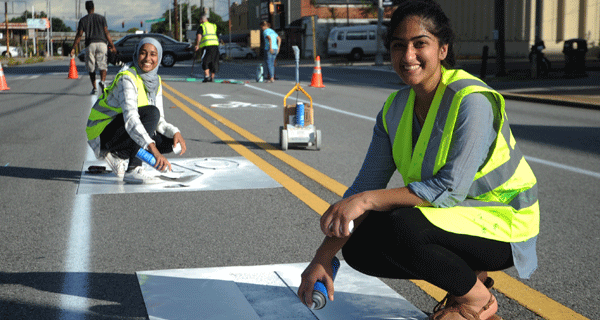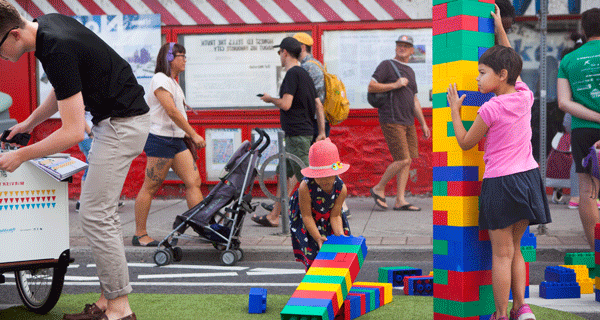12 Apr Informal Urbanism: A Global Perspective
This article originally appeared in Grand Circus Magazine, which was funded as part of the People First Project, a Knight Cities Challenge winning idea.
Great street art can be wondrous, providing fresh and challenging perspectives on art and on public space. The City of Toronto, recognizing this, created a street art program, one that provides grants to artists and supports the creation of street art on city property. Sounds fantastic, right?
The online journalism site Torontoist thinks otherwise. They recently featured an article asking if Toronto is losing something with its city sanctioned street art program. It’s great that graffiti is being embraced as an art form, the article states, but does sanitizing and standardizing it lose what makes graffiti such a vibrant art form in the first place?

Street art
The same question could be asked of tactical urbanism. No longer firmly outside the mainstream, municipal governments are becoming more and more comfortable with initiating pilot projects based on tactical urbanist principals. Is this a good thing? On one hand, it’s encouraging to see cities willing to experiment with accepted norms for built form. After decades of planning only for cars, it’s several breaths of fresh air to see cities prioritize people for a change. On the other hand, it seems like the exact same interventions are tried over and over again. These carbon-copied pilot programs often don’t take into account the surrounding neighbourhood context in which they occur. Furthermore, what data, if any, are cities gathering from these interventions? Are they truly efforts to effect change, or are they exercises in PR? Pilot project aren’t meant to be an end in themselves—they should be a means to help people re-think how we use public space and ultimately drive long-term change and investment in cities. How can we harness cities’s willingness to experiment so that we produce interventions tailored to local communities, and useful data that makes the case for more permanent improvements?

Macon Connects, street makeover. Photo courtesy of New Town Macon
One of the great strengths of the first tactical urban interventions is that they were truly grassroots. They were launched by people who had the lived experience of their neighbourhood, and understood its rhythms, needs and strengths. Roots couldn’t have been grassier. These local innovators created their installations based on the area’s needs. With Cities starting to take on the innovator role, one of the potential pitfalls they succumb to is using a one size fits all approach. Communities come in all different sizes and shapes, both in their built form, and their socio-economic make-up. Not every community needs umbrellas, beach chairs and fake grass. Cities must recognize this and adapt accordingly. If a community is lacking in economic opportunities, cities can copy Portland, Oregon’s Food Cart Pods program, tiny restaurant installations that serve as low cost micro-business stimulators. Is a neighbourhood struggling with accessing libraries? Your city can follow the pioneering example of Hudson, Wisconsin’s Little Free Libraries, using mailbox sized installations as places where residents can take and leave books free of charge. Having trouble encouraging active transportation? Look no further than Raleigh, North Carolina’s Walk Your City initiative, which uses informal wayfinding signage to give information on how long a walk local amenities are. These interventions work because they address an existing need in the community. Cities must tailor their own interventions in a similar manner, or the one size fits all approach becomes an exercise in window dressing rather than community building. As cities become more comfortable running pilot programs, the community driven roots of tactical urbanism must be honoured for the interventions to be successful.

Open Streets Toronto
Pilot programs are meant to be tests, but what good are tests if they don’t tell us something useful? A Buzz Feed quiz that doesn’t tell me something new about myself is a waste of time. Tactical urbanism, like street art, forces us to re-consider how we use and allocate public space. In order to effect more permanent changes, we need data to tell us what impacts our intervention is having. This is where cities can step up and their willingness to launch pilot programs is most exciting. Municipal government has the capacity local communities lack to scale-up pilot projects, accurately monitor the effects of interventions, and to have these results taken seriously. For example, Toronto is currently piloting a separated bike lane on Bloor Street, a main commercial, retail, and residential east-west corridor in the city. The pilot, which will run for a year, will be the most intensely studied intervention in Toronto’s history. There will be the usual data on the numbers of cyclists, motorists and pedestrians, but they will also be monitoring the impacts to accessibility, retail sales, customer transportation modal-share and commercial vacancies. Once completed, the pilot, while not without flaws (it could and should be longer) will have left a tangible legacy, a treasure-trove of data that can be applied not just to Bloor Street, but on cycling initiatives across the city. Toronto’s experience shows us that it isn’t enough for cities to initiate interventions, they also need to bring their greatest asset to the table and study the tar out of them. Data is the only way to make temporary interventions permanent solutions.

Pop-up Living Room, Charlotte, NC
Government is not known for being innovative. That’s why it’s encouraging to see cities willing to experiment with unorthodox solutions to urban issues. However, these interventions do not replace the need for long-term change and real investment in the public realm. They are a driver for change, not the change itself. If cities can pair their data gathering capabilities with interventions tailored to local communities, the experiments will lead to meaningful information and lasting change. If they don’t, then the interventions risk becoming positively Macbethian: full of sound and fury, signifying nothing.



